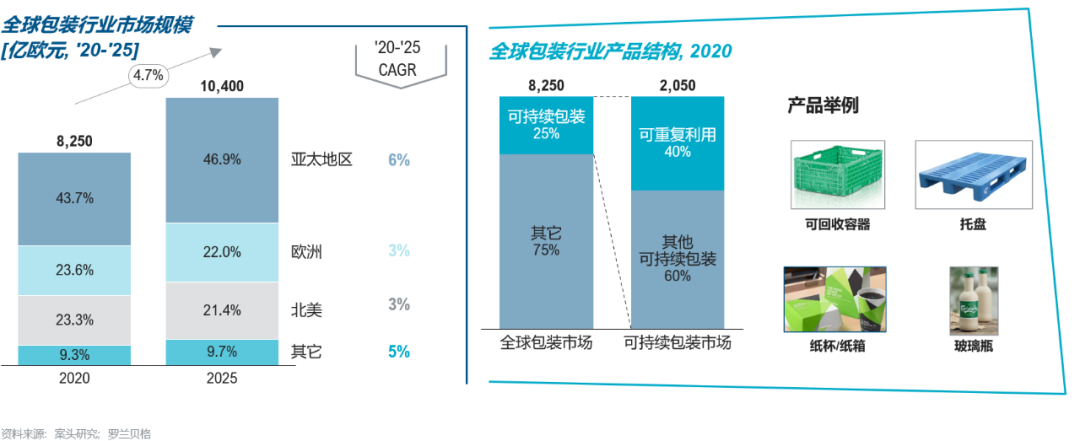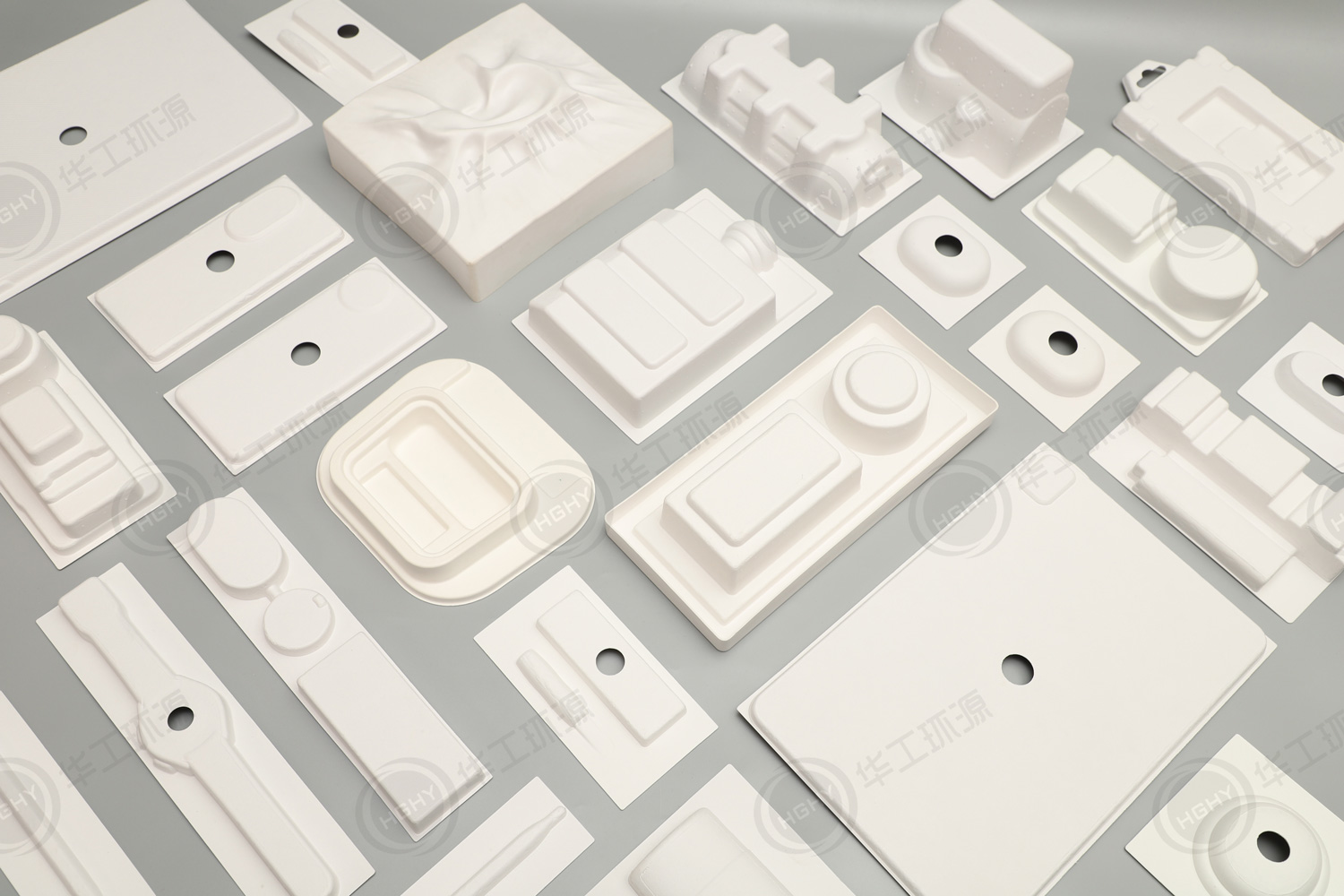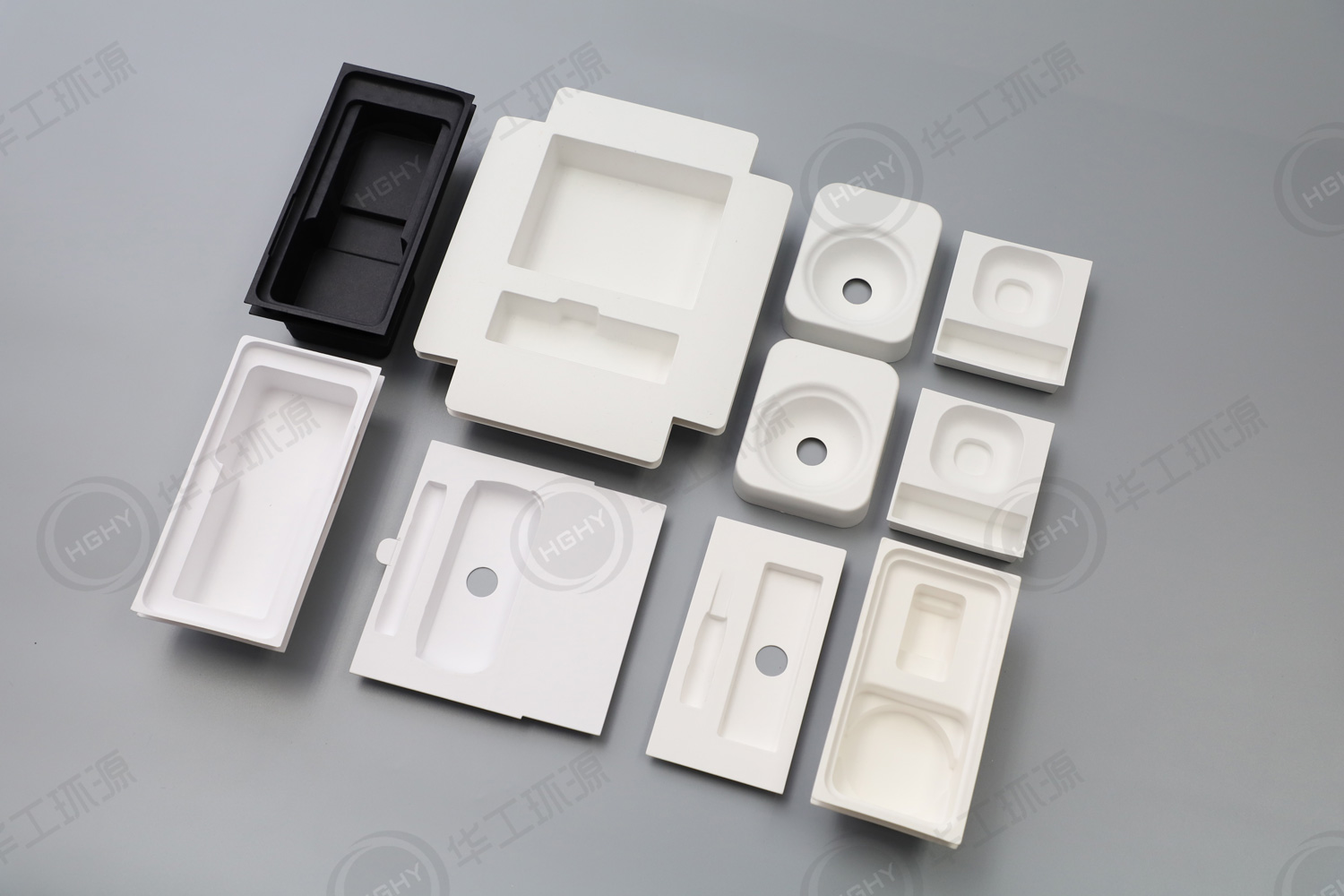The global sustainable packaging market is developing rapidly, the impact of packaging waste on the ecological environment has become a topic of common global concern, and the importance of sustainable packaging has become increasingly prominent. According to the latest statistics for 2021:
The number of plastic bottles consumed every minute in the world is about 1.2 million, an increase of 20% compared to 2020.
About 12 million tons of plastic enter the ocean every year, which has a huge impact on the marine ecology.
Only 14% of plastic packaging in the world is recycled, the remaining 15% is incinerated, and 70% remains in the natural environment.
 Global packaging industry market size and proportion of sustainable packaging
Global packaging industry market size and proportion of sustainable packaging
In response to packaging waste, sustainable packaging has experienced rapid growth in the past few years, with the global sustainable packaging market reaching approximately EUR 205 billion, accounting for 25% of the overall packaging market.
The strengthening of global environmental protection policies, the improvement of consumers' environmental awareness, and the increase of companies implementing sustainable development strategies have jointly driven the development and prosperity of the sustainable packaging market.
Global environmental policies continue to increase: In 2021, Australia announced a National Plastics Plan, which aims to ban single-use plastics by 2025. In addition to Australia, a growing number of countries and cities around the world are taking action to ban single-use plastics. In the EU, the 2019 Single-Use Plastics Directive aims to combat the 10 most common single-use plastic items found on European beaches, which account for 70% of all marine litter in the EU. In the United States, states such as California, Hawaii and New York have begun legislation to ban single-use plastic items such as plastic bags, forks and food containers. In Asia, countries such as Indonesia and Thailand have led calls for measures to ban single-use plastics.

Consumers are more environmentally conscious and willing to pay for sustainable packaging: 67% of respondents to a worldwide consumer survey believe that recyclable packaging is important and 64% believe that packaging with recyclable content is a priority in their buying decisions. Additionally, younger generations of consumers are more likely to buy sustainable packaging than older generations, with 83% of respondents aged 44 and under willing to pay more for sustainable packaging.
More and more consumer goods companies are emphasizing the sustainability of business development: With the increase in policy pressure and consumers' awareness of environmental protection, more and more global leading consumer goods companies have formulated corresponding sustainable development strategies. Reduce carbon emissions in all links such as manufacturing, logistics and distribution.
What was once called the e-commerce boom is now a way of life for consumers. U.S. digital retail sales topped $844 billion in 2020, and e-commerce is poised to become a trillion-dollar industry by 2022 as the lasting impact of the pandemic permanently changes consumer behavior. While omni-channel retailing offers consumers more convenience and choice, the accelerated growth of e-commerce has led to an urgent need for packaging materials and put pressure on the supply chain and the environment. The result is higher prices, more energy use and more waste involving paper and plastic packaging. Collectively, these impacts are exacerbating sustainability issues that cannot be ignored.

In 2018, the U.S. Environmental Protection Agency estimated that more than 30 million tons of packaging ended up in landfills, and recycling can only reduce a portion of the waste and isn’t even close to solving the problem. According to the Environmental Protection Fund's Center for Supply Chain Solutions, only 9 percent of plastic waste is properly recycled. Other studies found that 67 percent of manufacturers provided incorrect recycling information on labels. The effects of these deficiencies are devastating - images of waste spilling into landfills and oceans immediately come to mind, but lesser visual impacts include the massive carbon emissions from packaging production and the production of massive amounts of waste during the "last mile" Emissions from the supply chain of heavier packaging weights.
As countries around the world have higher and higher environmental protection requirements in the production and application process of various fields, with the advantages of environmentally friendly production and manufacturing process, wide application range, and more mature than other green materials, plant fiber molding packaging is comparable to degradable plastics, Bioplastic packaging products have become a leader in the packaging industry under the ban and restriction of plastics.
After years of precipitation and development, plant fiber molding packaging materials have gradually expanded to food, medicine, cosmetics, toys, home appliances, electronic products and other fields to replace traditional plastic foam, plastic lining and other packaging materials.

Specifically, plant fiber molding packaging materials have the following advantages:
Sustainable development for the environment
Plant fiber molding packaging is a three-dimensional papermaking technology. It uses plant fiber materials such as bagasse as raw materials, and uses special molds on plant fiber molding equipment to shape paper products of a certain shape. Due to the use of recycled materials in the production process, this type of packaging reduces the carbon footprint, the manufacturing process does not release high carbon emissions, and ensuring environmental safety is a big benefit of using it.
Biodegradable
Plant fiber molded packaging is also highly biodegradable. In addition to reducing carbon footprint, plant fiber molded packaging is compostable and naturally degradable. After use, plant fiber molded packaging will quickly decompose and completely decompose into soil a part of. In addition, it is non-toxic because it is biodegradable and made of non-allergenic materials, traditional packaging materials are made of petrochemical and synthetic materials, and exposure to heat will pollute the environment and release toxic gases.

Plant fiber molded packaging is reusable
The eco-friendly materials used to make it allow it to be reused after reaching its end-of-life. Plant fiber molded packaging can be reused to produce other environmentally friendly product packaging for various industries.
Cut costs
Plant fiber molded packaging is smaller than foamed plastic, lightweight, and can be overlapped, reducing excess space. This greatly reduces packaging waste, which in turn reduces overhead and shipping costs.
Plant fiber molding packaging enhances corporate image
The development and application of plant fiber molded packaging has become an inevitable trend of social development. Such products will also play a vital role in the development of various fields of society. With their social, economical, artistic, pollution-free , simple process and other advantages, will play a role in protecting the natural environment and improving the living environment.
At the same time, as a commodity, it has a very broad market space and development prospects, and will contribute to the development of the economy!




